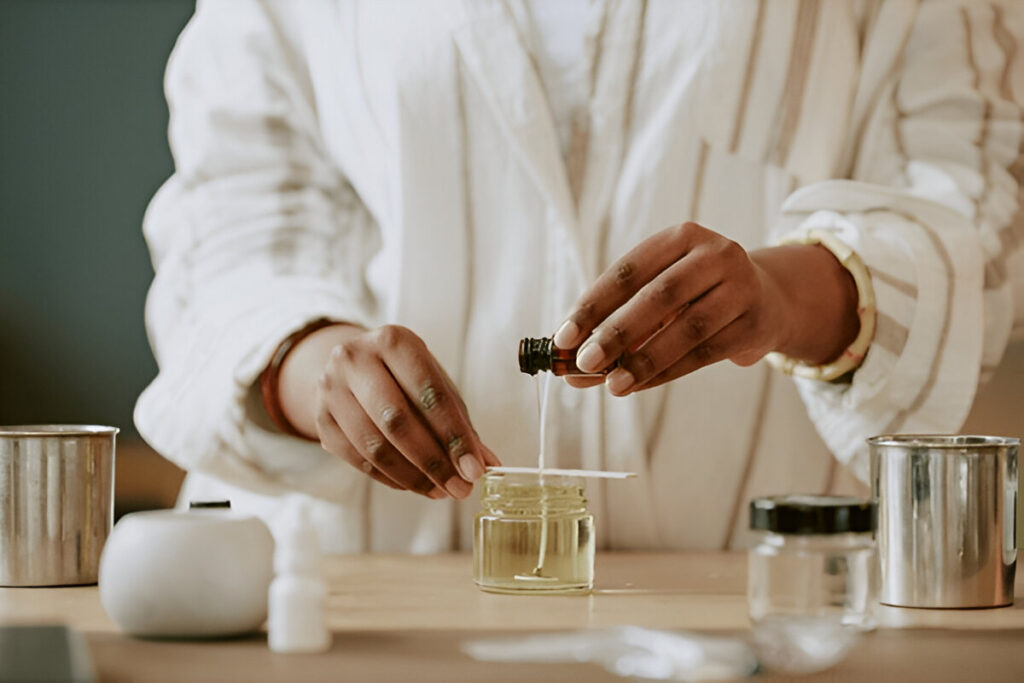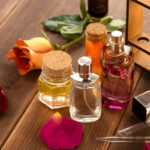Perfume-making blends nature’s equities and arts to transform them into irresistible fragrances. This article takes you through the fascinating process of how is perfume made, exploring your favorite smells from natural ingredients, formulating, mixing, blending, and bottling them into meticulous perfume. Discover the magic behind your favorite perfumes and what makes them so special.
It’s commonly thought that DIY makings are meant for women, but I’d like to share my story. Walking into the garden, I asked my husband, these lavenders and lilies are my weaknesses, I can’t resist their fragrance.
After a month, I was surprised as my hubby made a perfume for me from lilies, lavender, vanilla, and cedarwood, and that was the ever-best gift from someone. Since then, I keep annoying my husband (on a lighter Note), “Why spend a fortune on those glitzy bottles with the same kinda smells when my dearie can make for us, trust me we made most fun while making our sumptuous perfume!
The blog covers, carefully selecting special ingredients to blend them into unforgettable scents and diving into the secrets behind irresistible luxury fragrances, trust me this experience is beyond imagination.
The Art of Perfume Making
Perfuming-making practices have a deep-rooted history that stretches back thousands of years, from ancient civilizations like Egypt and Mesopotamia.
Initially, they were made from natural oils and aromatic materials like flowers, herbs, or spices. Over time, the process has evolved blending traditional perfume-making practices with contemporary scientific techniques.
To understand the making of perfume you must involve yourself in compositions, solvents, oils, fixatives, etc. In this way, you’ll be successful in making long-lasting fragrances. There are only three basic steps to follow:
- Sweet-smelling aromatic components that make your perfume super-duper. These could be from floral, citrusy, woody, oriental, or marine backgrounds.
- Now you have extracted your aromatic compounds, it’s time to dissolve them into a solvent that is alcohol, or vodka. Ahaa, this alcohol is not for drinking but is used to offer your perfume a medium of interaction.
- You can fix your perfume by stabilizing the fragrance and to do so you can use glycerine or water.
Step 1: Sourcing the Ingredients
Perfume making starts with sourcing the right ingredients, which may come from natural or synthetic well-springs. Natural extracts from fruits, flowers, and wood form the base, while iconic ingredients like rose, jasmine, sandalwood, and vanilla add the middle or base notes of signature scents. However, synthetic ingredients are produced in laboratories and are often used to replicate the natural ingredients.
It’s your choice to pick up the right ingredients from gardens or order synthetic ones, readily available in stores.
Tips & Tricks: The use of the finest quality ingredients is important in perfume making, as the purity and richness of these elements have a high impact on the final fragrance profile rely on rare, exotic ingredients like agarwood or ambergris, a natural byproduct of whales sperm.
Step 2: Extraction of Essential oils
Fragrance oils are true nature’s essence that comes from the flora and fauna of the beautiful world. These are picked, cleaned, pressed, and extracted by steaming, and ingenious perfume oil is here to boost your sharp witty looks.
There are five ways to extract essential oils:
-
Solvent Extraction: Let your wizard magic take out a portion of fragrance from plants, and blitz by sneaky-peaky solvent. Perfect to spill the scent magic naturally from these delicate flowers, without heating. Here, the good kids acting as solvents are ether, benzene, coconut, or jojoba.
-
Steam Distillation: Stealing the floral or herbal essence by steaming them to low heat. The steam allows the ingredients to come on top with water being condensed back. This is a bit fancy way to extract oils!
-
Expression: No solvent, no heat method. This process uses a pressure technique to extract oil, it is an easy way to get an enchanting gush. Best for citrusy extract, orange mandarin, lemon, or oranges.
-
Enfleurage: This extraction is done by mixing ingredients into a lipid medium, through which oil seeps, is scrapped, and dried to have flowery powder. Kind of messy and slow extraction!
-
Maceration: Botanical infusion dunking into oil to have the steeping, cozy, and warmth of real floral incense. Slowly, after days, a perfectly brewed fragrance will evolve, pure nature’s extract is here!
Step 3: Blending the fragrance
Now is the time to ride the roller coaster as the laborious process of mixing & blending with keen observations has begun, once you have prepared all the ingredients. Let’s rewind what things you may need:
- Fragrance oil from roses, lilies, lavenders, sandalwood, cedar, oakmoss, coffee, vanilla, saffron, citron, oranges, apple, pear, grass, and the list continues. Just a glimpse of the versatility you can achieve in essential oil!
You can add as many ingredients as you want, but the more you add the more you need to be artistic!
- Alcohol Solvent: The percentage of alcohol decides the intensity of your perfume and is overlooked mostly. If you are thinking of creating a lingering fragrance then alcohol is a stride hit. Usually, top notes evaporate with alcohol, leaving behind base notes to settle on your skin. Normally, Eau de perfume has 15-20% of perfume oil while the rest is alcohol. Alcohol is a Buzzkill but smells way good in your luxury fragrance.
- Water as a diluter, if you think your prepared scent is strong, add a few drops of water to lighten the notes, while if you feel it’s not the strongest version then add a little fragrance extract.
- Lastly Fixative, glycerine, or animal substances like ambergris, musk, castor, coal tar, mosses, resin, etc.!
Using fixatives is worthy, as it elevates the shelf life of scent, and reduces the evaporation of fragrance molecules.
Step 4: Dilution & Bottling
The final stage arrived, oh yes!
Now we’ll be adding essential oil into alcohol, and creating our hearty scent. Here combining, mixing & blending is the rule of Law, which means you will be concentrating essence with ethanol by the simple formula:
Fragrance oil: 15-20 %
Ethanol: 75-80%
That means you’ll be encountering: A total of 6ml oil + 24 ml of alcohol in a perfume bottle of 30 mL.
After this, your perfume is ready to bottle up, but make sure you allow it to settle down for at least a month so that the notes mature with alcohol and outshine your look!
Epic Uses to Experiment Perfume Making
- Perfumes are meant for internal satisfaction that improves your personality and if you’re crafting it yourself, then for sure; you understand what complements you.
- The igniting perfume’s fragrance can uplift moods, aiding relaxation and calmness. You can host yourself with a boost of energy.
- Wearing a self-made scent can alter your expression at any gathering you attend.
- The time you spend making a perfume will leave a memorable impression.
- You can look for more range and low-cost products that no one else is wearing.
Conclusion
How is perfume made by balancing the notes with alcohol is a memorable experience. You will be extracting essential oil, diluting the concentration with alcohol or a little water, and letting it settle down. The masters in perfumery have designed a simple formula combining the extract with alcohol, so don’t put pressure on your nerves. Just a little research and trusting your instinct won’t make you regret perfume making —Stealing the show, and carrying elegance with exceptionally crafted perfume will be your iconic symbol!



